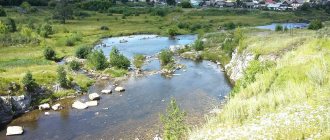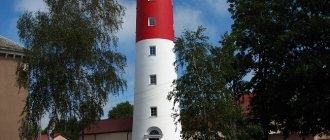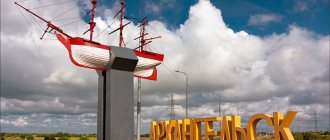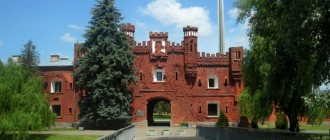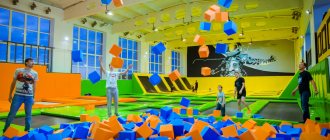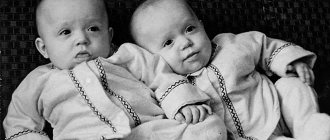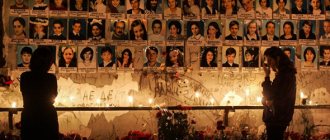Weather
The climate in Brest is temperate continental, reminiscent of Moscow.
It rains frequently throughout the year. Summer is warm, the average daytime temperature is about +19 °C. July is considered the warmest and rainiest month. June and August are a little cooler and less rainy. Winters are mild, with frequent thaws. The average winter day temperature is −3°C. Snow usually falls in late December and melts in early March. It is better to come to Brest from May to September, when it is warm and clear. More information about the weather in Brest
Brest today
Brest
– a significant industrial center, since the development of industrial enterprises in the region is facilitated by its favorable geographical border location. Among the largest are Brestselmash, a hosiery factory, and carpet production. Brest liquor and vodka products are famous for their quality.
Recently, visas were canceled for residents of 80 countries wishing to visit Brest. It has become even easier to visit Belarus, plunge into the charm of the hero city, and see the beautiful Belarusian nature.
You will remember your walk around Brest for a long time!
Sights of Brest
Start your tour of the city from the Brest Fortress. This is the main attraction of the city; it preserves the memory of the first days of the Great Patriotic War and the heroic resistance of Soviet soldiers, who were the first to take on the Nazi attack on June 22, 1941.
Kholm Gate of the Brest Fortress
On the territory you can see the restored ruins of the fortress, a moat, and a memorial. And around there is a beautiful park with a quiet, calm atmosphere. You cannot pass by the Monument of Courage - a 36-meter stone bust of a warrior. This is a monument to everyone who gave their lives but never surrendered to the enemy.
Monument "Courage"
The Brest Fortress Defense Museum is located in a former barracks. Here you can see real samples of weapons, documents, photographs of defenders, paintings, military uniforms, and models of the Brest Fortress.
The Berestye Museum is also open on the territory of the fortress, where the exhibits are much older. It is dedicated to the life of the ancient Slavs. Here you will see 28 wooden houses from the 13th century, two wooden pavements, a palisade and more than 42 thousand other artifacts that were found during excavations.
Archaeological site of a wooden town of the 13th century in Berestye
After visiting the museums, take a walk along the main pedestrian street of Brest - Sovetskaya. Residents of the city love it very much, because it is here that there are most beautiful buildings and cozy cafes. Since 2009, Sovetskaya Street has been illuminated by 17 vintage kerosene lanterns. Every day they are lit and extinguished by the same lamplighter, the only one in Belarus. This mesmerizing action takes place at sunset. The exact time will be told to you by the special clock “Lamp Lighting Time,” installed at the beginning of Sovetskaya Street, near Masherov Avenue. They say that if you make a wish and rub one of the buttons on an old lamplighter's uniform, it will definitely come true.
Clock on Sovetskaya Street
Visit the famous alley of lanterns on Gogol Street, opened in honor of the anniversary of the liberation of the city from fascist invaders. There are 41 lights along the alley, all of which were installed by local businesses. And since the alley is located on Gogol Street, there are also “literary” lanterns: depicting the devil from the book “Evenings on a Farm near Dikanka”, the praying Khoma Brut from “Viy” and other characters from Gogol’s works.
Lantern with a sculpture of an angel on Gogol Street
If you have time, be sure to explore the Brest railway station building. It is tall and majestic, like a palace. And, by the way, Brest Station is one of the largest in Belarus.
The main attractions of Brest with descriptions and photos
Brest – the heroic city of Belarus
The Brest region extends across the southwest of our country. It neighbors Poland and Ukraine. This explains the peculiarities of the local dialect. The region consists of 16 districts and 3 cities of regional subordination: Brest, Baranovichi, Pinsk. The population of the capital of the Brest region is slightly more than 340 thousand inhabitants. Considering the geographical location of the city on the border with the Republic of Poland, Brest is a large transport terminal. There are three customs checkpoints near it, major transport routes pass through the city, such as E30 (Berlin-Warsaw-Brest-Minsk-Moscow), and there is also a river port on the river in the settlement itself. Mukhavets.
Pages of the history of the city of Brest
The territory of the Brest region has long been inhabited by Slavic and Baltic tribes. It alternately joined the states of that time: the Grand Duchy of Lithuania, the Polish-Lithuanian Commonwealth, the Russian Empire, and the Polish Republic. The current outlines of the Brest region were assigned to it only in 1954.
The Brest region represents a colorful and outstanding layer of cultural heritage of Belarusians. You can see this with your own eyes, because there are about 30 museums here. Each of the museums is interesting in its own way. For example, the museum “Saved Art Treasures”
is the only museum in Belarus where works of art and rare items that were seized by customs officers in Brest are exhibited.
Along with museums, the following monuments of historical and cultural heritage are of great interest: Brest Fortress, Belovezhskaya Pushcha, Kamenets Tower, Puslovsky Palace, Ruzhany Palace, Suvorov Museum.
Brest for children
A great idea for family leisure is a trip to the legendary Belovezhskaya Pushcha. This is one of the best European nature reserves, included in the UNESCO World Heritage List. Magnificent forests with winding hiking trails, rare animals in their natural environment, developed infrastructure - everything is provided here to make a walk through the national park unforgettable. Children will most enjoy visiting the residence of Father Frost - the Belarusian master of winter Zyuzya lives here.
You can continue your acquaintance with the fauna, only this time exotic, at the ostrich farm, the largest in the CIS. More than 200 adult birds and a hundred funny chicks live here. You can watch the ostriches on your own or hire a guide, and then take a chance and feast on ostrich meat, known for its unique taste.
Another interesting place for children and adults is the open-air Museum of Railway Equipment (website). More than 50 exhibits are presented here, through which you can trace almost the entire history of railway transport.
Brest region is proud of them
- Begin Menachem (1913) , Israeli statesman and politician, lawyer. Prime Minister of Israel from 1977 to 1983. Nobel Peace Prize laureate (1978). Died in 1992. In 2013, a bust of Begin was erected in Brest
- Blagoveshchensky Alexey Sergeevich (1909) , Lieutenant General of Aviation (1943), Hero of the Soviet Union (1938). During the Great Patriotic War he fought on the Leningrad, Kalinin, 1st Baltic, 1st Ukrainian, 3rd Belorussian fronts. The commander of the fighter air corps Blagoveshchensky in June - July 1944 participated in the liberation of Orsha, Vitebsk, Minsk, Molodechno, Lida. Until 1960 he served in the Soviet Army Air Force. Died in 1994.
- Grommer Yakov Pinkhusovich (1879) , Belarusian mathematician and theoretical physicist, Doctor of Philosophy (1914). Author of scientific works on algebra, theory of transcendental functions, general theory of relativity. Together with Einstein, he was the first to show that field theory can contain a theory of the mechanical motion of particles of substances. Died in 1933.
- Demeshko Alexander Sergeevich (1947) , Belarusian pop artist, percussion performer, Honored Artist of Belarus (1979). From 1969 to 1988 he was a drummer in the vocal and instrumental ensemble “Pesnyary”. Died in 2006.
- Karvat Vladimir Nikolaevich (1958) , first Hero of Belarus (1996). In 1981-1994 he served in the Air Force in the Far East: flight commander, squadron commander, deputy regiment commander for flight training. Since August 1994, in the Armed Forces of Belarus, head of air-fire and tactical training at the air base. During a night training flight on May 23, 1996, Lieutenant Colonel Karvat took his burning plane away from the village of Bolshoye Gatishche, Baranovichi district, and died.
- Makushev Vikenty Vasilievich (1837) , historian, philologist-Slavist, corresponding member of the St. Petersburg Academy of Sciences (1878), doctor of history (1871). He served in the Asian Department of the Ministry of Foreign Affairs, as secretary of the Russian consulate in Dubrovnik (Austrian Empire). Upon returning to his homeland, Makushev retired and devoted himself to science. In 1867 he defended his master's thesis, and later his doctorate. Died in 1883.
- Yulia Viktorovna Nesterenko (1979) , Belarusian athlete (athletics, running), Master of Sports of Belarus (1997), Master of Sports of Belarus of international class (2001), Honored Master of Sports of Belarus (2005). Olympic champion (2004). Bronze medalist of the World Championship (2004). Winner of international Grand Prix competitions (2004). Bronze medalist at the World (2005) and European Championships (2006).
According to BELTA
07/16/2014.
News on the topic: history, our city Views: Subscribe to Brest News in Google Read BrestCITY in Yandex.News ———————-
Transport
Brest's public transport network includes about 10 trolleybus and 50 bus routes, as well as many minibuses going in different directions. The best way to navigate the city is with a map or guidebook. The cost of travel on buses and trolleybuses is 0.55 BYN, tickets are sold at Brestgortrans kiosks at bus stops or in newspaper stands. You can also buy a ticket from the driver, but it will cost a little more: 0.6 BYN. The fare on commercial route No. 50, connecting the Tsvetotron and Adamkovskaya stops, is 0.50 BYN. A ten-day pass for one type of transport costs 6.30 BYN, for both - 8.50 BYN. You can ride a minibus for 0.6 BYN. Since 2022, it has become possible to pay for a trip using a smartphone - you need to buy a ticket in the application and redeem it when boarding the transport.
Another convenient way to get around the city is a taxi: you can catch one on the street, but it’s easier to call one by phone or via the Internet. For landing you will need to pay from 2 BYN, for each km - 0.4-0.6 BYN.
If you want to change your four-wheeled vehicle to a two-wheeled one, rent a bicycle. Rental points are located throughout the city, half an hour of skiing will cost from 2 BYN, 2 hours - from 7 BYN, 4 hours - from 12 BYN. The city has paths and bicycle parking.
Brest Hotels
In Brest there are hotels of varying degrees of comfort: affordable hostels, Soviet-style hotels with a minimum of frills, as well as several fashionable establishments with improved rooms and European service. Cozy rural estates and hunting houses for rent, located, as a rule, in picturesque corners on the banks of lakes and rivers, deserve special mention.
Travelers on a limited budget most often choose hostels, where accommodation costs from 20 BYN per bed in a shared room. The golden mean is three-star hotels with rooms starting from 65 BYN per night. 4 “stars” - so far only at the Hermitage Hotel (from 245 BYN per day) and the Rynkovka Estate tourist complex with environmentally friendly rooms (from 82 BYN per day). An alternative to hotels is apartments with their own kitchens: a one-room apartment can be rented for 50 BYN per day.
Communications and Wi-Fi
The main Belarusian mobile operators are Velcom, MTS and Life. You can connect a SIM card at company offices located in shopping centers, supermarkets, train stations and other public places.
Payphones are installed throughout Brest. Telephone cards with denominations from 30 to 480 tariff units are sold in post offices and newsstands, the price is 1.2-3.85 BYN. Calls within the CIS cost from 56 tariff units per minute.
Free Wi-Fi is available in hotels and restaurants located in the city center. In many public places you can connect to the Internet using Beltelecom prepaid cards.
7 things to do in Brest
- Watch how the lamplighter lights up the night on the street. Soviet.
- Honor the memory of war heroes in the Brest Fortress.
- Wander through the spiral staircases of the medieval White Tower.
- See a bison in its natural environment and meet Father Frost's brother Zyuzya in Belovezhskaya Pushcha.
- Eat the “Zubrovka” with “mother-in-law’s snack” or pancakes with “Machanka”.
- Replenish your wardrobe with fashionable ethnic clothing with traditional Belarusian patterns.
- Find out what smugglers do at the Museum of Salvaged Valuables.
Story
Origin and name
Brest is a city with a rich and ancient history. Based on the year of its foundation, Brest is the fourth city in Belarus. Only Polotsk (862), Turov (980), and Vitebsk - 974 were founded before Brest. Over the course of its history, the city has changed its state affiliation more than once; is now located at the very junction of the territories of the European Union and the Commonwealth of Independent States, near the place where the borders of three Slavic countries - Belarus, Ukraine and Poland - meet.
The ancient name of Brest is Berestye. The city was first mentioned in the “Tale of Bygone Years” under the year 1019 in connection with the struggle of the prince of Turov and the great Kyiv Svyatopolk Vladimirovich with his brother, at that time the Novgorod prince Yaroslav Vladimirovich (Yaroslav the Wise) for the grand princely throne of Kiev. The inhabitants of the city were called Berestyans. The name most likely comes from the word “berest” (a type of elm) or from “birch bark” (the outer layer of birch bark).
In 1863, the ethnographer P. M. Shpilevsky wrote down a legend about the origin of the name of Brest, associated with the trip to Lithuania of a rich merchant with his comrades. Suddenly the road was blocked by a swamp, around which many birch trees grew. They cut down the trees and were able to cross the swamp along the birch flooring. They came to an island, which was formed by a large river and a small river flowing into it. and the fact that everything went well, the merchant decided to thank the pagan god Veles and built a temple on the island. After some time, returning from Lithuania, where there was successful trade, the merchant and his comrades again stopped at the Velesov kapish, built huts and founded a city, which they called Berestye.
Alley
In chronicles of the 12th - 13th centuries the name Berestiy is also found, in historical documents of the 16th century - Berest (this name was common among residents of the city’s environs until recently). In the 17th century - early 20th century the city was called Brest-Litovsk, in 1921-1939 - Brest-nad-Bug, from September 1939 - Brest.
Middle Ages
The ancient origin of the city was confirmed as a result of archaeological excavations on the cape formed by the Western Bug River and the left branch of the Mukhavets River. Scientists discovered the ancient settlement of Brest (now the territory of the Volyn fortification of the Brest Fortress). It consisted of a detinets triangular in plan, with an area of about 1 hectare, fortified on the floor side with a ditch, an earthen rampart and a palisade, and a round town (posad), which was located opposite the detinets on the island. The finds indicate the development of crafts, trade and cultural ties with the cities of ancient Rus' and with neighboring countries. Archaeological research allows us to conclude that Brest arose on the territory of settlement of the Dregovichi - an East Slavic tribal association, the Berestey settlement existed in the 11th - 13th centuries, Detinets was founded at the turn of the 10th - 11th centuries. Nowadays the Berestye Archaeological Museum has been created on its territory.
Monument to the Millennium of Brest
In the 11th century, Berestye was an ancient Russian trade center and fortress on the border with Polish and Lithuanian possessions. The place where ancient Berestye was located was located at the intersection of two ancient trade routes. One of them walked along the Western Bug from Galician Rus and Volyn to Poland, the Baltic states and Western Europe, the other along Mukhavets, Bolot, Pina, Pripyat, Dnieper and connected Berestye with Kiev, the Black Sea region, and the Middle East. Due to its border location, the city was often the object of internecine struggles and military clashes, passed from hand to hand, and was looted and destroyed more than once. Since the second half of the 12th century, Berestye has been part of the Vladimir-Volyn principality (since 1199 of the Galician-Volyn principality), in chronicles it is mentioned in 1153 as the possession of Prince Vladimir Andreevich, in 1173 - Prince Vladimir Mstislavich.
In the 12th century, in Berestye, which was once again conquered by the Poles, King Casimir the Just built a wooden castle (rebuilt in the second half of the 13th century), a fortification for trade caravans. In Berestye they charged a fee (duty) for transporting goods. In the 1240s, the Berestey land, which was still the subject of rivalry between the Galician-Volyn and Polish princes, was under threat of conquest by the Mongol-Tatars. In the second half of the 13th century, Berestye was owned by the Volyn prince Vladimir Vasilkovich, under whom a stone donjon tower was built on the territory of the castle in 1276-1288, and the stone church of St. Peter was erected. The tower subsequently helped the townspeople withstand brutal sieges. In 1319, the Grand Duke of Lithuania Gediminas “without much resistance” annexed the Berestey land to the Grand Duchy of Lithuania.
Brest railway station
In 1379 the city was attacked by the Teutonic knights. They failed to take the castle, but the city was plundered and burned. In connection with the constant threat of aggression from the Teutonic Order and to combat it, the Grand Duchy of Lithuania and Poland entered into an alliance in 1385 - the Union of Krevo.
Part of the Principality of Lithuania
At the end of the 14th century, Berestye was a trade and craft center of the Grand Duchy of Lithuania, the population was about 2 thousand inhabitants. Local merchants exported furs, leather, timber, hemp, grain to Western Europe, imported salt, cloth, silk, paper and much more. Merchants from other Belarusian cities, as well as from Vilna, Kyiv, Chernigov, and Moscow passed through Berestye. In 1380, a guest house was built in the city, fairs were organized, and crafts actively developed: pottery, blacksmithing, leatherworking, jewelry, shoemaking, sewing, and woodworking. In 1390, Berestye was the first of the Belarusian cities to receive self-government on the basis of Magdeburg law. The management of the city began to be carried out by a rada, consisting of lavniks, radtsy, two mayors (Catholic and Orthodox), who alternately presided over it.
Further economic development of Berestye was delayed by the great war of 1409-1411 of the Kingdom of Poland and the Grand Duchy of Lithuania against the Teutonic Order. At a secret meeting in the city in December 1409, the Polish king Jagiello and the Grand Duke of Lithuania Vytautas developed a plan for a general battle with the crusaders. In the Battle of Grunwald on July 15, 1410, the Teutonic Order was defeated; The Berestey banner fought as part of the united armies. In 1441, Berestye was officially classified as the main city of the Grand Duchy of Lithuania.
The city's attractions
By the end of the 15th century, there were already more than 5 thousand inhabitants in Berestye, 928 built-up areas. The city has been exempt from paying taxes more than once. In 1500, the city was plundered by the troops of the Crimean Khan Mengli I Giray. Since 1520, Berestie has been the center of the powiat of the Podlaskie voivodeship, since 1566 - the center of the Brest voivodeship. In 1554, according to the privilege of Sigismund II Augustus, Berestia was allowed to use an official seal with the image of a hipped tower at the confluence of two rivers.
In the 16th century, Berestye was an important trade and craft center of the Grand Duchy of Lithuania. Brest merchants maintained close trade ties with important trading centers of Eastern Europe: Slutsk, Minsk, Mogilev, Polish Warsaw, Poznan, Torun, Lomza, Lublin, cities of Ukraine, the Russian state. The city's annual trade turnover reached 750 thousand rubles in the first half of the 16th century, and Brest customs took second place in the state treasury's revenues. In the 1550s, the Brest elder Nikolai Radziwill Cherny founded a printing house in the city, the first in Belarus. In 1563, the Brest Bible was printed in it, which is an outstanding monument of book printing. In the second half of the 16th century - the first half of the 17th century, religious brotherhoods, which were organized at Catholic monasteries and Orthodox churches, were of great importance in the socio-political life of townspeople.
17th century
By the second half of the 17th century, the city center was formed on the island (now the Citadel of the Brest Fortress). There was a shopping area with a town hall and shops, stone buildings of Jesuit, Basilian, Bernardine monasteries, a Uniate church, and a synagogue. In 1659, the Brest Mint was founded, where in 1664-1666 small copper coins - solidi - were minted with the image of the “Pahonia” - the coat of arms of the Grand Duchy of Lithuania.
Brest center
In the 17th century, Brest-Litovsk became a meeting place for military confederations (1605, 1612), and the Sejm of the Polish-Lithuanian Commonwealth (1653). During the Russian-Polish War of 1654-1667 and the war unleashed by Sweden in 1655 against the Polish-Lithuanian Commonwealth and in 1656 against Russia, Brest-Litovsk was repeatedly in the zone of hostilities. On November 15, 1655, Russian troops under the command of the Novgorod governor, Prince S.A. Urusov, appeared near Brest-Litovsk, but failed to take the fortified city, which had a strong garrison. The army of the Hetman of the Grand Duchy of Lithuania P. Ya. Sapega then knocked out the troops of Urusov, located across the river. In 1657, the Swedes captured Brest Castle and the city. As a result of military operations, especially the invasion of Khovansky’s detachments, Brest-Litovsk was “destroyed and burned down to the last building,” the population remained “a very small handful,” all members of the magistrate were killed, shop documents and magistrate books were burned.
During the Northern War of 1700-1721, under an agreement with the Polish-Lithuanian Commonwealth, the Russian army entered the territory of Belarus in 1705. Provision warehouses were created in the city to supply the Russian army; in 1706, Peter I was passing through. In 1706, Swedish troops, pursuing the retreating army of Peter I, occupied Brest-Litovsk and destroyed it. The second half of the 17th century - the first half of the 18th century in the history of the city is characterized by a sharp economic decline caused by prolonged wars, famine and epidemics. The number of its inhabitants decreased, handicraft production and trade fell into decline. Only in the second half of the 18th century did the economy begin to revive. Brest-Litovsk became the main river port on the Western Bug, through which grain, hemp, timber, etc. were exported. In the 1770s, Lithuanian court treasurer Anthony Tizengauz founded a cloth factory in Brest-Litovsk, which had 7 looms. Constitution May 3, 1791
Brest Fortress
In 1792, this was the residence of the leaders of the Targowica Confederation. In 1795, Brest-Litovsk was annexed to Russia as a result of the third partition of the Polish-Lithuanian Commonwealth. As a district town, it was first part of the Slonim province, from 1797 to the Lithuanian province, and from 1801 to the Grodno province. The city was gradually built up, in 1797 there were 623 houses, of which 21 were stone, a cloth factory and a distillery. Fires caused great damage to the city: in 1802, about 160 houses burned down, in 1822 - the commercial part of the city (150 shops) and 70 residential buildings.
War years
During the Patriotic War of 1812, on the territory of the Brest land, the French army faced serious resistance from the Third Western Russian Army under the command of General Alexander Petrovich Tormasov. On July 25, near Brest-Litovsk, the advanced units of the Russian troops, led by Major General A.G. Shcherbatov, defeated the enemy cavalry units and forced the French troops to leave the city.
At the end of the war, the Russian military decided to build a fortress in Brest-Litovsk, as an element of the created fortification system in the west of the country. The Brest Fortress was built according to a project approved in 1830 on the territory of the city. As a result, the former city, which existed for more than 500 years, was practically destroyed. In 1835, urban development was moved to the east by 2 km, boundary markers were installed between the lands of the city and the fortress - rubble pillars (one of them has been preserved at the corner of Lenin and Gogol streets). On April 26, 1842, the grand opening of the new fortress took place.
City street
As part of the Russian Empire, the city finally received a respite from endless wars and raids. But the district Brest-Litovsk was only a pale copy of that prosperous and important city of the Polish-Lithuanian Commonwealth, which once existed between the Mukhavets and Bug rivers. The economy developed slowly, the city was actually an “annex” to a strategic fortress, its life was entirely dependent on the military. In 1825, about 11 thousand people lived in the city, in 1845 - about 18 thousand people. In Brest-Litovsk there were 250 shops, auctions were held 3 times a week, and 2 fairs annually. With the development of capitalism in the second half of the 19th century - the beginning of the 20th century, the city, previously three-quarters consisting of wooden houses and barracks, began to be built up, stone residential and public buildings, various enterprises and workshops were erected, and its territory expanded.
The growth of the city at the end of the 19th century was associated with the large-scale modernization of the Brest-Litovsk fortress (1878-1888) and, in particular, the accelerated construction of railways connecting Brest with the center of Russia, Poland and Ukraine. In 1869, the Brest-Warsaw road was put into operation, in 1871 - Moscow-Brest, in 1873 - Kyiv-Brest, in 1886 - Brest-Gomel. In 1886, the railway station building was built, which has been illuminated with electricity since 1888 (160 light bulbs were installed in the halls, office premises and on the platforms).
Real Brest
According to the 1897 census, the city's population was 46,568. However, the city had neither running water nor sewerage; Almost the entire population used water from Mukhavets; in 1896, only 5 wells in the city had potable water. There was one hospital with 15 beds. Since 1865, there was a four-grade gymnasium, in the late 1870s - city four-grade and parish schools, a private boarding school for noble maidens, from 1874 - a private library, from 1885 - an amateur musical and dramatic society, in 1903-1904 they were built two gymnasiums.
Temples
- Alexander Nevsky at the serf hospital (inactive, lost)
- Alexander Peresvet and Andrey Oslyabi, temple-chapel at the border outpost (under construction)
- Athanasius of Brest, temple of the Afanasyevsky Monastery
- Annunciation of the Mother of God, temple of the Simeonovsky Monastery (inactive, dismantled in 1834)
- Resurrection of Christ, cathedral church-monument of the Great Victory
- Joy to all who mourn, icons of the Mother of God
- All-Tsarina, icons of the Mother of God
- St. George the Victorious
- Demetrius Donskoy, temple-chapel
- John the Russian
- The Life-Giving Cross, Church of the Mother of God of the Nativity Monastery (inactive, lost)
- Nicholas the Wonderworker
- garrison cathedral
- fraternal temple
Temples included in the city deanery
- John the Theologian in the village. Cherny
- Ksenia of Petersburg in the village of Telmy-1
- Peter and Paul in the village. Kosichi
- Intercession of the Blessed Virgin Mary in the village. Kamenitsa-Zhirovetskaya
- Nativity of the Virgin Mary in the village. Shchebrin
Cuisine and restaurants of Brest
Brest has many cafes and restaurants with cozy interiors, delicious food, affordable prices and excellent service. The best establishments are concentrated on Sovetskaya Street, the local Arbat. There are colorful cafes with traditional Polesie dishes, Italian pizzerias, and atmospheric coffee shops with a wide range of drinks and desserts. The highlight of many establishments is days of national cuisines from different countries of the world.
Most traditional Polesie treats are prepared from meat and fish. You should definitely try the “mother-in-law appetizer” - smoked meats seasoned with horseradish, as well as stuffed pike and all kinds of homemade sausages. The most popular soups are borscht, solyanka and ukha.
It is impossible to visit Belarus and not try “bulba” - potatoes prepared in a hundred different ways: boiled, fried, baked, stewed with meat and mushrooms. And, of course, pancakes!
Among the drinks, local dark beer (it is expertly brewed here), mead and “crambambula” made with honey and spices deserve attention. For those who like to “raise the temperature”, we recommend “Zubrovka” - a bitter and strong herbal tincture.
In the vicinity of Brest there are many rural estates where guests are happily offered dishes made from organic products: from ruddy piglets to fluffy pancakes with “machanka”. For national flavor, you can also look into the Svayaki tavern with a traditional interior, a varied menu (the preparation time is indicated opposite each dish) and reasonable prices.
Lunch for one in an inexpensive Brest cafe will cost 10-15 BYN; many establishments offer discounts during the day. For dinner for two in a good restaurant you will need to pay 60-100 BYN.
About the city
The city of Brest is located on the southwestern side of Belarus and is the administrative center of the region. The total area of the city today is 146 km². According to 2016 data, its population is about 340 thousand people. The Western Bug and Mukhovets flow through the territory of the settlement. Borders with Poland. There is a large junction of railways and river navigation, as well as road transport. The named settlement has an ancient and rich history. The first mention of it is contained in the First Novgorod chronicle and dates back to 1017. Based on these data, Brest can be considered the fifth city in Belarus in the chronology of education. The ancient city was often destroyed and rebuilt again, it passed from the hands of one ruler to another, obviously, the reason for this was its location. Now it is located on the territory between the Eurasian and European Unions.
Sovetskaya Street, Brest
Beaches of Brest
There are several equipped beaches and recreation areas on the Mukhavets River and nearby lakes. You can swim in some of them: the water is constantly checked to ensure compliance with sanitary and epidemiological standards. The cleanest and safest is the Vostok beach on the right coast of Mukhavets, not far from the Guznyansky Bridge. There are toilets, changing cabins, playgrounds, and boat and catamaran rentals. The surface is sandy, the entrance to the water is gentle.
The next most popular spot for beach lovers is the “Red Dvor” recreation area on a picturesque lake formed on the site of a quarry. There is also sand here, the water is warm and clean, but it gets too deep: children can swim only under the supervision of their parents. There are changing rooms, dry closets and garbage containers on the territory, there are free sun loungers and umbrellas, but there are clearly not enough of them for everyone.
But on the Central Beach, equipped on both banks of Mukhavets in the area of the bridge on Shevchenko Boulevard, swimming is strictly prohibited. It’s not too safe in the recreation area “Grebnoy Canal” on the street. October Revolution: in the summer of 2015 alone, swimming here was restricted four times.
